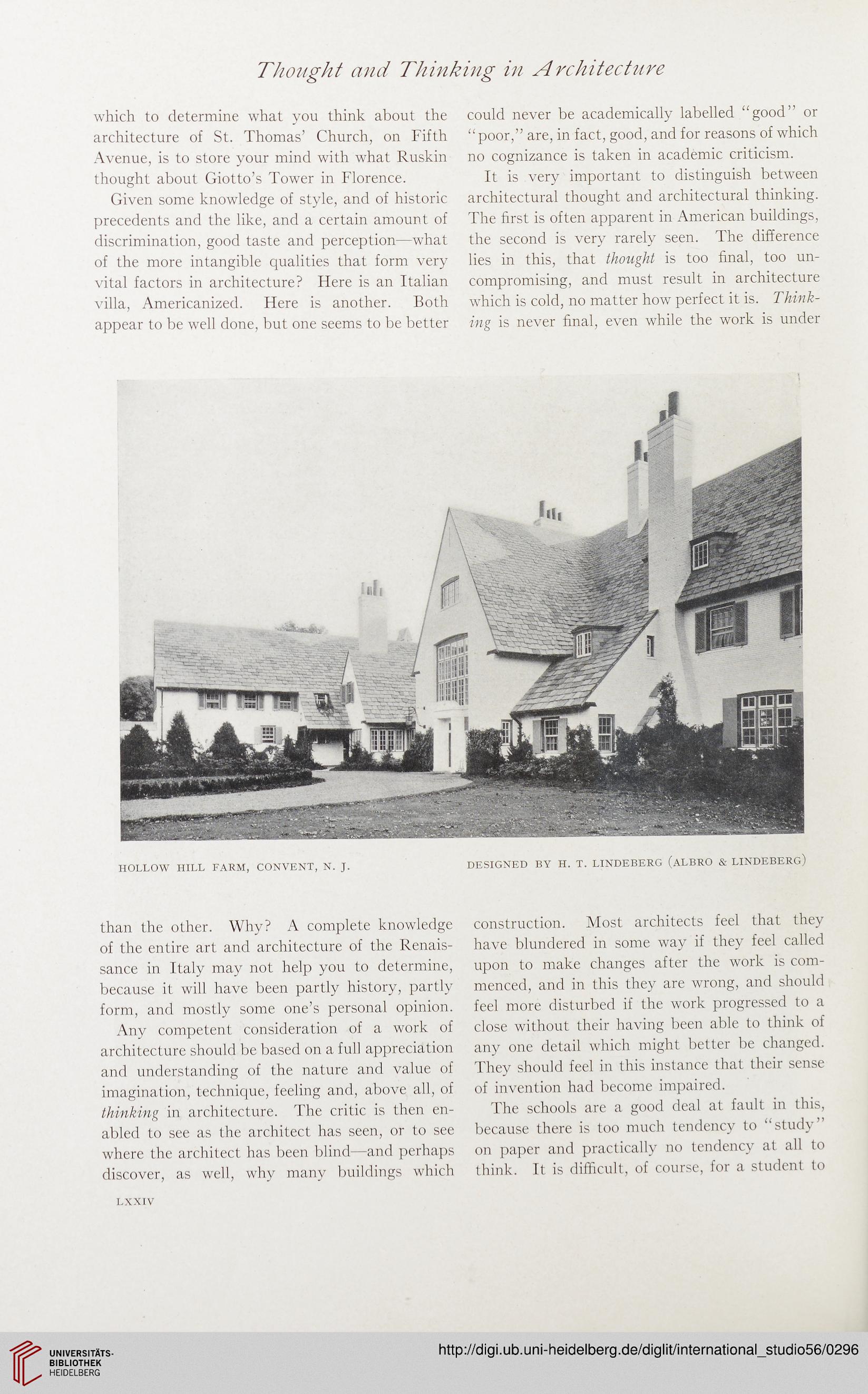Thought and Thinking in Architecture
which to determine what you think about the
architecture of St. Thomas’ Church, on Fifth
Avenue, is to store your mind with what Ruskin
thought about Giotto’s Tower in Florence.
Given some knowledge of style, and of historic
precedents and the like, and a certain amount of
discrimination, good taste and perception—what
of the more intangible qualities that form very
vital factors in architecture? Here is an Italian
villa, Americanized. Here is another. Both
appear to be well done, but one seems to be better
could never be academically labelled “good” or
“poor,” are, in fact, good, and for reasons of which
no cognizance is taken in academic criticism.
It is very important to distinguish between
architectural thought and architectural thinking.
The first is often apparent in American buildings,
the second is very rarely seen. The difference
lies in this, that thought is too final, too un-
compromising, and must result in architecture
which is cold, no matter how perfect it is. Think-
ing is never final, even while the work is under
HOLLOW HILL FARM, CONVENT, N. J.
DESIGNED BY H. T. LINDEBERG (ALBRO & LINDEBERG)
than the other. Why? A complete knowledge
of the entire art and architecture of the Renais-
sance in Italy may not help you to determine,
because it will have been partly history, partly
form, and mostly some one’s personal opinion.
Any competent consideration of a work of
architecture should be based on a full appreciation
and understanding of the nature and value of
imagination, technique, feeling and, above all, of
thinking in architecture. The critic is then en-
abled to see as the architect has seen, or to see
where the architect has been blind—and perhaps
discover, as well, why many buildings which
construction. Most architects feel that they
have blundered in some way if they feel called
upon to make changes after the work is com-
menced, and in this they are wrong, and should
feel more disturbed if the work progressed to a
close without their having been able to think of
any one detail which might better be changed.
They should feel in this instance that their sense
of invention had become impaired.
The schools are a good deal at fault in this,
because there is too much tendency to “study”
on paper and practically no tendency at all to
think. It is difficult, of course, for a student to
LXXIV
which to determine what you think about the
architecture of St. Thomas’ Church, on Fifth
Avenue, is to store your mind with what Ruskin
thought about Giotto’s Tower in Florence.
Given some knowledge of style, and of historic
precedents and the like, and a certain amount of
discrimination, good taste and perception—what
of the more intangible qualities that form very
vital factors in architecture? Here is an Italian
villa, Americanized. Here is another. Both
appear to be well done, but one seems to be better
could never be academically labelled “good” or
“poor,” are, in fact, good, and for reasons of which
no cognizance is taken in academic criticism.
It is very important to distinguish between
architectural thought and architectural thinking.
The first is often apparent in American buildings,
the second is very rarely seen. The difference
lies in this, that thought is too final, too un-
compromising, and must result in architecture
which is cold, no matter how perfect it is. Think-
ing is never final, even while the work is under
HOLLOW HILL FARM, CONVENT, N. J.
DESIGNED BY H. T. LINDEBERG (ALBRO & LINDEBERG)
than the other. Why? A complete knowledge
of the entire art and architecture of the Renais-
sance in Italy may not help you to determine,
because it will have been partly history, partly
form, and mostly some one’s personal opinion.
Any competent consideration of a work of
architecture should be based on a full appreciation
and understanding of the nature and value of
imagination, technique, feeling and, above all, of
thinking in architecture. The critic is then en-
abled to see as the architect has seen, or to see
where the architect has been blind—and perhaps
discover, as well, why many buildings which
construction. Most architects feel that they
have blundered in some way if they feel called
upon to make changes after the work is com-
menced, and in this they are wrong, and should
feel more disturbed if the work progressed to a
close without their having been able to think of
any one detail which might better be changed.
They should feel in this instance that their sense
of invention had become impaired.
The schools are a good deal at fault in this,
because there is too much tendency to “study”
on paper and practically no tendency at all to
think. It is difficult, of course, for a student to
LXXIV




